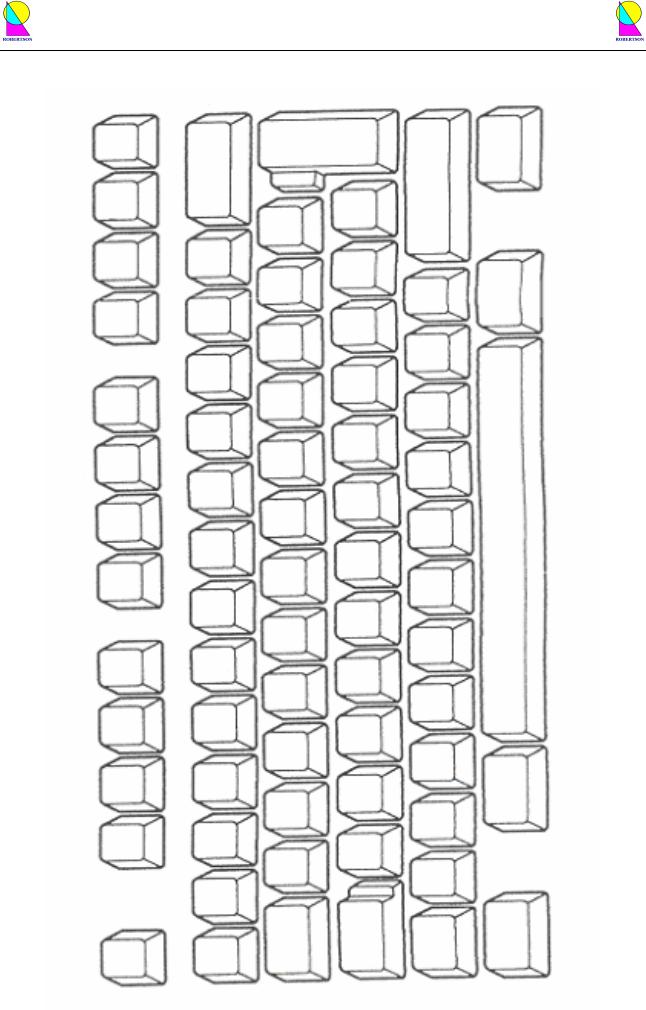
Robertson G.D.A practical introduction to APL-1 & APL-2.2004
.PDF
A Practical Introduction to APL1 & APL2
A Practical Introduction to
APL 1
&
APL 2
by
Dr Graeme D. Robertson GraemeDR@nildram.co.uk
. . . TRAINING THAT WORKS . . .
Date: ..................................
Place: ...................................
Tutor:
Students:
...................................................................................
...................................................................................
.......................................................................................................................
.......................................................................................................................
.......................................................................................................................
.......................................................................................................................
.......................................................................................................................
1

A Practical Introduction to APL1 & APL2
ROBERTSON (Publishing)
15 Little Basing, Old Basing,
Basingstoke, RG24 8AX, UK.
Copyright © Graeme Donald Robertson 2004
This publication may be used, reproduced, stored in a retrieval system, or transmitted in any form or by any means, electronic, mechanical, photocopying, recording or otherwise, without the permission of the publisher.
This document is distributed subject to the condition that it shall not, by way of trade or otherwise, be sold or hired out without the publisher’s prior consent. It may however be used in APL classes and circulated in any form of binding or cover with a similar condition, including this condition, being imposed on the subsequent owner.
First edition published March 2004 as APL1&2.PDF
Second edition published September 2004 as APL1_2.PDF
Conduct of this 2 day course:
After short introductions, the student group is invited to divide up into pairs. Each pair works on one computer/terminal for the duration of the course.
Each pair is given the first lesson and asked to work through it on their computer at their own pace.
Pairs are encouraged to help each other with new concepts and difficulties as they arise and to experiment on the computer with any ideas which they think they can express in APL statements.
Tuition is given when problems cannot be resolved by the pair. Questions may be answered directly on matters of fact, or indirectly by way of a suggestion as to how the problem might be tackled.
Each day covers about 7 lessons, depending upon the pace of each pair.
There is no pressure to complete all lessons (remaining notes are given out at the end of the course).
At the discretion of the tutor, lessons may be skipped or assigned for private study after the course has ended.
Short synopses are given (with an overhead projector or white board) at suitable intervals throughout the course to the group as a whole.
2

A Practical Introduction to APL1 & APL2
A Practical Introduction to
APL 1&2
APL is the only language to have been 200 years in the debugging. Ken Iverson
Day 1: First Generation – APL 1
APL 1 - Core APL
Session 1
APL Character Set
APL Keyboard
Primitive Functions
Simple Arrays
Assignment of Variables
Indexing & Special Syntax
Error Messages
Session 2
User-Defined Functions
Editing Functions
Local & Global Variables
Order of Execution of Functions
System Commands
APL Idioms
...learning by practice, by induction, and by heuristic methods...
...pragmatic teaching by encouraging experiment and by individual tutorial. Ken Iverson
3

A Practical Introduction to APL1 & APL2
L E S S O N 0
Why Learn APL?
APL is a high-level, general-purpose, intuitive programming language which is designed to be easy on the programmer and hard on the computer - through power, not inefficiency.
APL has its own special character set of around 200 alphabetic characters and symbols. Each individual symbol performs a specific task making programs very concise, though often illegible and unintelligible to the uninitiated. Nevertheless, APL is A Programming Language which is essentially simple and easy to learn. APL is interactive making it possible to experiment with different ideas while developing solutions.
Getting to KnowYour APL Keyboard
Your computer should be set up already so that an APL session is visible and has the focus. Typing on your keyboard should cause characters to be displayed on your screen. Try typing something. When you come across a new symbol, or key combination, write it on the supplied blank keyboard. This will help you quickly to become familiar with the new APL key layout.
Symbols which require the Shift key to be pressed should be written in the upper left hand corner of the corresponding key cap on the supplied blank keyboard chart. Symbols which require the Ctrl and Shift keys to be pressed should be written in the upper right hand corner of the corresponding key on the chart. Symbols which require the Alt key to be pressed should be written on the front of the corresponding key, as shown below. (Beware of Ctrl keys on a mainframe.)
∙Type the numbers 0 to 9 on your keyboard and write them in the lower left hand corner of the corresponding key on your keyboard chart. Type in the upper case letters A to Z on your keyboard and write them in the appropriate positions on the keyboard chart.
∙Find the symbols and on the keyboard and write them on your chart. Find the symbols ¹ and Ù on the keyboard and write them on your chart. Use the backspace key to rub out the typing. Put that key on your chart too.
∙In APL each expression which is typed into the APL session is executed when the Enter key is pressed. In mainframe APL2 the key which is used to enter expressions is the right Ctrl key, and possibly also the numeric pad Enter key. Mark the appropriate key on your chart.
∙Ask your tutor for LESSON 1.
4

A Practical Introduction to APL1 & APL2
5

A Practical Introduction to APL1 & APL2
L E S S O N 1
Simple Arithmetic Expressions
Go at your own pace. Experiment. Try to work it out. Think. Talk about it.
∙Use APL to add any two numbers together. Check the result. For example, type
Hint: Hit the Enter key when you are ready to execute the line containing the cursor.
Notice how, in immediate execution mode, APL indents the cursor 6 spaces to indicate that it is ready to process the next line of user input. Everything which has been input by the user is indented by 6 spaces, and is coloured green in mainframe APL2. Output from the computer starts at the left hand margin and is coloured red, as are error lines.
∙Type the following two lines into your session and explain the results.
‘
Notice the distinction between the negate function ( ) and the negative sign, or high minus symbol, (‘) which is an intrinsic part of a number, like the decimal point.
Symbols such as and can be used either with a single right argument (which is called the monadic or prefix case) or with a left and right argument (which is called the dyadic or infix case). Thus the hyphen symbol can be used monadically to mean negate or dyadically to mean minus, or subtract. Write the new high minus symbol on your keyboard chart.
The plus and minus signs were introduced by the German mathematician Johann Widmann in 1489 to signify addition and subtraction. Dyadic deployment of the symbols is now familiar to everyone.
APL has many such powerful primitive functions which allow complex computations to be done very easily. Primitive functions follow the principle of one symbol per mathematical operation.
∙Experiment to see if you can deduce the monadic and dyadic meanings of the symbols ¹ Ù_ y z —both by applying simple numeric arguments, and by inference from the form of the symbol itself:
The times sign was introduced by the English mathematician William Oughtred (1575 - 1660). Its use to signify multiplication is now familiar to everyone who has been exposed to the language of elementary algebra. How many computer languages use the simple times sign to indicate multiplication? Most still use *. You can begin to see why Ken Iverson said, "APL is the only language to have been two hundred years in the debugging."
6

A Practical Introduction to APL1 & APL2
APL is derived from mathematical notation. It did not appear from the standard evolutionary origins of most other computer languages. APL crystallized from an unconstrained theoretical notation (Iverson notation) when it was realized that it could be executed on a computer. "I wasn’t trying to design or implement a language for a machine," confessed Iverson.
The monadic meanings of¹ Ù_y z —and are direction, reciprocal, magnitude, ceiling, floor, exponential, natural logarithm and factorial respectively. The dyadic meanings are multiply, divide, residue, maximum, minimum, power, logarithm and binomial respectively.
∙ Investigate the monadic meaning of Experiment with suggestive arguments! |
;-) |
The result of one expression can be used as the argument to another function.
∙Try some compound expressions such as
¹
and
¹
Hence explain the result of the expression
Beyond BIDMAS. Remember BIDMAS (or BODMAS)? It tells you the order of precedence in simple arithmetic expressions – brackets first, then indices, division, multiplication, addition and finally subtraction. APL, on the other hand, does not assume any special order of precedence between functions. Execution simply proceeds from right to left unless you use parentheses (round brackets) to control the order of execution. All APL functions have equal priority. This basic “right-to-left” grammatical rule applies to dyadic functions and monadic functions alike in APL. (It’s a bit like the rule in English that the object of a sentence comes after the verb.)
Rule 1: The right argument of any function, monadic or dyadic, is the result of the entire expression immediately to its right.
Some functions take boolean arguments and return boolean results.
∙Reading 1 as true and 0 as false, verify the truth values of these expressions.
•
A A • •
a • a
These invoke the simple logical functions: and (A), or (•) and not (~).
7

A Practical Introduction to APL1 & APL2
∙Some functions take numeric arguments and return boolean results. Verify the results of
Ù
!
These introduce simple binary relational functions: equals ( ), less-than ( ) and greater-than (!).
∙Trigonometric functions are implemented via the dyadic circle function. A left argument of 1 returns the sine of the right argument. Assess the result of
“
knowing that Sin(π) is zero. A left argument of 2 returns the cosine, 3 returns the tangent.
The left argument of the circle function may be any integer between 12 and -12 representing various standard pythagorean, trigonometric, hyperbolic and complex number functions.
∙Explore a few examples. Find the meaning of the monadic circle function.
∙Type the following line into your session and execute it a few times.
"
What do you think the results indicate about the meaning of roll (")? -
∙Try some more adventurous examples of the application of Rule 1.
z
y‘
z‘ y‘
_‘
" j" • " k"
a l m j j j
Ù ¹
¹ — — A Ù — —
∙Ask your tutor for LESSON 2.
8

A Practical Introduction to APL1 & APL2
9

A Practical Introduction to APL1 & APL2
L E S S O N 2
Names, Lists & Literals
Numbers and results of expressions can be assigned to names. The left assignment arrow may be read as gets or is-assigned or simply is.
∙Enter the following statements (or sentences)
,17(5(67 f
<($56 f
9$/8(f ¹ ,17(5(67 <($56
∙Type in the name of a variable and hit the Enter key to display the contents of the variable in the
session.
9$/8(
Generalized Scalar Functions. Some functions that take single numbers (scalar) arguments have well defined behaviour when the arguments are extended to lists of numbers (vector).
∙Execute the line
and explain the result.
Addition of vectors is not a new concept. Newtonian mechanics (1687) employs 3 element vectors to describe positions, velocities and forces in 3D space. Addition of forces may be represented
by lines and parallelograms, as below, and is calculated by vector addition, using the plus sign, as above.
N-dimensional vector spaces (containing N-element vectors) are now employed routinely in many branches of pure and applied mathematics. Indeed the concept of a vector space is one of the principal unifying concepts in the whole of mathematics.
"The use of a programming language in which elementary operations are extended systematically to arrays provides a wealth of useful identities," says Dr Kenneth Iverson in his book A Programming Language, Wiley 1962.
10
